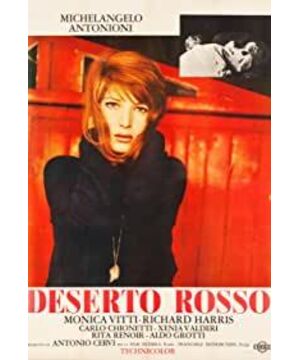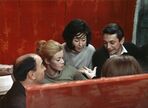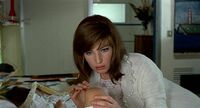As the director of neo-realism, Antonioni creates a situation that is purely visual (auditory), which is different from the perceptual effects extended by actions in traditional realism situations. His situation is more about taking the audience into the film. In the movie, the character becomes the audience to some extent. In the film, the girl walks around unconsciously and seeks. The environment she encounters is more of an existence beyond the scope of experience. She cannot make corresponding judgments and actions on the environment she encounters. It is more like recording rather than reacting. She is subject to a certain perspective, being tracked and recorded.
Antonioni's movies are always good at making wonderful excavations from the dull timeline of daily life. In this film, we see that the empty scene and the environment seem to be devouring the movements of the characters, becoming an abstract symbiosis. At the same time, we found that the connection of scenes is so fragmented, either disjointed or transcendent. Therefore, the audiovisual situation no longer comes from the extension of action, but forms a kind of symbol: visual symbol and auditory symbol. Sometimes they are the daily situations experienced by the characters, and sometimes they are subjective images, such as some empty shots, dreams, hallucinations, etc. But at the same time we feel a kind of uneasy alienation and objectivity in Antonioni's images. In the film’s heroine’s search for lust, she is always stiff, helpless, and even resistant to lust, just like some kind of "distance" between people. It is in this sense that Lez introduced the concept of critical objectivism. Antonioni’s aesthetic perspective is always closely related to objective criticism: love is so pathological, in such a desolate and decadent modern industrialized society, love is so painful, then what is love? How do we have love?
Antonioni is always “verifying an event rather than explaining it.” His objective images follow a destiny impersonally, a fixed expansion of the ending, which can accept the break in the timeline and the rapid insertion of random space. Like these two shots in the movie
Gradually transitioning from a disjointed space to an empty mirror space, the character suffers not so much the pain caused by the absence of others, but rather the extreme emptiness and fatalism of the absence of lust. From then on, this space refers to the blank gaze of a person who bears the absence of self and the absence of the world, "a visual drama replaces traditional drama."
Antonioni believes that if there is a problem with our lust itself, it is because lust itself is pathological. It is included in a pure form of time, and he also believes that time itself is a disease. Therefore, time symbols and reading symbols are inseparable, and they force us to read each symptom. In other words, not only the sense of sight and hearing, but also the past and present, the colors that can be seen everywhere in the film constitute such a symptom, which can be deciphered, but can only be deciphered in an action similar to reading. . For example, the randomly changing three primary colors in the scene in the film are a kind of transcendental "symptoms" related to semiotics. Our interpretation of color erosion and mutual change is closer to reading than pure perception.
View more about Red Desert reviews









